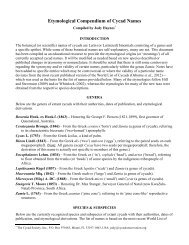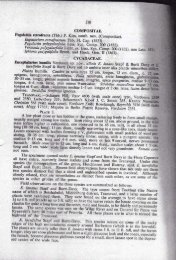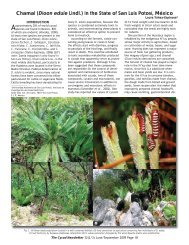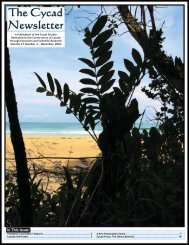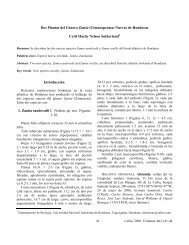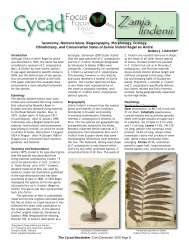CYCAD ECOTOURS in México with Jeff Chemnick
CYCAD ECOTOURS in México with Jeff Chemnick
CYCAD ECOTOURS in México with Jeff Chemnick
Create successful ePaper yourself
Turn your PDF publications into a flip-book with our unique Google optimized e-Paper software.
Cycad<br />
Focus<br />
Focus<br />
Taxonomic History, Conservation<br />
Status & Morphologic Affi nities<br />
of Encephalartos kisambo FADEN &<br />
BEENTJE<br />
Jody Haynes<br />
Focus<br />
INTRODUCTION<br />
Encephalartos kisambo FADEN &<br />
BEENTJE, the ‘Voi cycad,’ is a large, stately<br />
plant from the Voi region of Kenya (and<br />
possibly Tanzania [see below and the<br />
article on pp. 6-14, this issue]). Even<br />
though it is not typically suitable for small<br />
gardens due to its impos<strong>in</strong>g size (Fig. 1),<br />
it has become a fairly common species<br />
<strong>in</strong> both private and public collections<br />
worldwide. While it is now fairly wellknown<br />
<strong>in</strong> cultivation, many collectors<br />
and enthusiasts may not be familiar <strong>with</strong><br />
the <strong>in</strong>tricacies of its taxonomic history,<br />
conservation status, or morphologic<br />
affi nities. This article will provide<br />
<strong>in</strong>formation from early records of the<br />
species (before it was formally described),<br />
from its formal description <strong>in</strong> 1989 (and<br />
its synonym, E. voiensis MORETTI, D.W.<br />
STEV. & SCLAVO from later the same year),<br />
and from the recent description of E.<br />
kanga from northeastern Tanzania that is<br />
considered by some to be noth<strong>in</strong>g more<br />
than a reddish-coned population of E.<br />
kisambo.<br />
THE DISCOVERY<br />
Whitelock (2002) reported that<br />
Encephalartos kisambo was discovered <strong>in</strong><br />
1970 near Voi, Kenya, by Robert Archer,<br />
who was an American work<strong>in</strong>g <strong>in</strong> the<br />
East African Herbarium <strong>in</strong> Nairobi. Jones<br />
(1993) had earlier given the date as 1973<br />
and ascribed no one <strong>in</strong> particular to the<br />
discovery, while Goode (1989) suggested<br />
that the species was discovered dur<strong>in</strong>g<br />
one of Heenan’s expeditions <strong>in</strong>to central<br />
and eastern Africa <strong>in</strong> 1973-74. If one<br />
exam<strong>in</strong>es the list of specimens provided <strong>in</strong><br />
the orig<strong>in</strong>al description (Faden & Beentje,<br />
1989), it becomes clear that Archer<br />
had, <strong>in</strong>deed, discovered (and collected<br />
specimens of) E. kisambo <strong>in</strong> 1970—prior<br />
to Heenan’s expeditions—as had Robert<br />
Faden the follow<strong>in</strong>g year.<br />
Regardless of which of the above<br />
dates is correct, it should be no surprise<br />
that the species was not mentioned <strong>in</strong><br />
Focus<br />
Focus<br />
Melville’s (1957) comprehensive treatment<br />
of the cycads of central Africa, <strong>in</strong><br />
Melville’s contribution to Turrill and Milne-<br />
Redhead’s (1958) Flora of Tropical East<br />
Africa, or <strong>in</strong> Lewis’s (1960) contribution to<br />
Flora Zambesiaca. In fact, the fi rst known<br />
published <strong>in</strong>formation on the species was<br />
<strong>in</strong> Heenan’s (1977) revision of the central<br />
and eastern African cycads nearly two<br />
decades later. Us<strong>in</strong>g data and specimens<br />
collected by his son (Heenan, 1977; Dave<br />
Heenan, pers. comm.), Heenan reported<br />
the follow<strong>in</strong>g about the “imperfectly<br />
known” species that he referred to simply<br />
as “Encephalartos sp. ‘B’ (‘Voi’)”:<br />
Trunk up to 2.2 m high, 0.35-0.6 m<br />
diameter, <strong>with</strong> a tendency to taper towards<br />
the top. Leaf scars very irregular <strong>in</strong> size and<br />
shape vary<strong>in</strong>g from horizontally distended<br />
triangles 30 by 60 mm to parallelograms 60<br />
by 80 mm. The most noticeable feature of<br />
this species is the unusually swollen base of<br />
the rachis <strong>with</strong> the subsequent dist<strong>in</strong>ctive<br />
leaf scars on the caudex. Leaves ma<strong>in</strong>ly<br />
oblong, rounded at apex and narrow<strong>in</strong>g<br />
gradually to the base, up to 3.7 m long by<br />
0.65 m wide. Leafl ets l<strong>in</strong>ear lanceolate,<br />
pungent, coriaceous, 250-350 mm long by<br />
30-40 mm wide, overlapp<strong>in</strong>g and ma<strong>in</strong>ly<br />
subopposite, becom<strong>in</strong>g trifurcate, bifurcate<br />
and fi nally <strong>with</strong> up to 15 pairs of sp<strong>in</strong>es<br />
term<strong>in</strong>at<strong>in</strong>g about 80 mm from the base<br />
of the greatly swollen rachis, which is not<br />
grooved. Median leafl ets usually <strong>with</strong> 4-6<br />
dist<strong>in</strong>ct sp<strong>in</strong>es on the upper marg<strong>in</strong>, usually<br />
<strong>with</strong> 3-4 of these sp<strong>in</strong>es close to the basal<br />
attachment; lower marg<strong>in</strong> entire, sometimes<br />
<strong>with</strong> up to two smaller sp<strong>in</strong>es; under-surface<br />
clearly striate <strong>with</strong> 30-45 parallel nerves.<br />
Th[is] species occur[s] ... S.E. of Voi<br />
..., Kenya <strong>in</strong> the Maunga Mounta<strong>in</strong>s at an<br />
altitude of about 1000 m [specifi c locality<br />
<strong>in</strong>formation <strong>in</strong>tentionally removed]. The<br />
colonies are to be found ... grow<strong>in</strong>g <strong>in</strong><br />
partial shade and <strong>in</strong> open country. It is<br />
worth not<strong>in</strong>g that all specimens grow<strong>in</strong>g <strong>in</strong><br />
the open reached only two-thirds the size<br />
of those <strong>in</strong> partial shade <strong>with</strong> regard to<br />
both trunk and leaf development, probably<br />
<strong>in</strong>dicative of the more favourable humid<br />
conditions under the forest canopy.<br />
Heenan (1977) also provided a sketch (Fig.<br />
2) of a median leafl et of “Encephalartos<br />
sp. ‘B’ (‘Voi’)” next to leafl ets of his<br />
“Encephalartos sp. ‘A’” (which would<br />
later be described as E. sclavoi DE LUCA,<br />
D.W. STEV. & A. MORETTI) and a “form” of<br />
E. laurentianus DE WILD. from Mpanga,<br />
The Cycad Newsletter 32(1) March 2009 Page 15<br />
Encephalartos<br />
kisambo<br />
Uganda (which would later be described<br />
as E. whitelockii P.J.H. HURTER).<br />
THE SPECIES GETS A NAME (OR TWO)<br />
Encephalartos kisambo<br />
Faden and Beentje (1989) published<br />
their description nearly 20 years after<br />
its discovery and a dozen years after<br />
Heenan fi rst wrote about it. They credited<br />
Heenan (1977) for the fi rst report of this<br />
species <strong>in</strong> the literature and expla<strong>in</strong>ed<br />
that ‘kisambo’ is the local name for the<br />
plant <strong>in</strong> the Taita language. They also<br />
stated that the plants typically grow <strong>in</strong><br />
evergreen mist forest and occasionally<br />
on exposed slopes <strong>in</strong> dry bushland at<br />
altitudes of 800-1050 m. Accord<strong>in</strong>g to<br />
the authors, this species was, at that<br />
time, known <strong>with</strong> certa<strong>in</strong>ty only from a<br />
very small area—approximately 160 ha <strong>in</strong><br />
size—<strong>in</strong> the Maungu Hills. While Heenan<br />
(1977) had reported it from two other<br />
locations, Faden and Beentje warned that<br />
these additional reports would require<br />
confi rmation.<br />
Faden and Beentje (1989) went<br />
on to say that Encephalartos kisambo<br />
is “perhaps most closely related to E.<br />
hildebrandtii,” which they reported<br />
differs from the latter <strong>in</strong> hav<strong>in</strong>g falcate<br />
leafl ets <strong>with</strong> fewer marg<strong>in</strong>al serrations,<br />
larger male cones <strong>with</strong> less sharply<br />
Fig. 1. Three large plants of Encephalartos kisambo<br />
<strong>in</strong> a private garden <strong>in</strong> Homestead, Florida.<br />
Fig. 2. Median leafl ets of Encephalartos kisambo (A),<br />
E. sclavoi (B), and E. whitelockii (C) (modifi ed from<br />
Fig. 1 of Heenan [1977]).
defl exed bullae, female cones <strong>with</strong><br />
shallower bullae and trapezoidal rather<br />
than rectangular median facets, and<br />
orange-yellow rather than red seeds<br />
(Fig. 3). It also reportedly differs from E.<br />
tegulaneus MELVILLE <strong>in</strong> hav<strong>in</strong>g larger, more<br />
closely spaced leafl ets that lack serrations<br />
on the lower marg<strong>in</strong>, male cones <strong>with</strong><br />
shorter median sporophylls and bullae<br />
that are more defl exed, and female cones<br />
<strong>with</strong> narrower and shallower bullae on<br />
the median sporophylls. It differs from E.<br />
bubal<strong>in</strong>us MELVILLE, then, by hav<strong>in</strong>g larger<br />
leaves and leafl ets, larger male cones<br />
bear<strong>in</strong>g median sporophylls that are larger<br />
and proportionately narrower, and female<br />
cones <strong>with</strong> narrower bullae. F<strong>in</strong>ally, the<br />
authors reported that E. kisambo differs<br />
from E. sclavoi (which had not yet been<br />
described), <strong>with</strong> the latter hav<strong>in</strong>g much<br />
smaller leaves and leafl ets that either<br />
lack serrations entirely or have only one<br />
or two on the lower marg<strong>in</strong>.<br />
Interest<strong>in</strong>gly, Faden and Beentje<br />
(1989) also mentioned that the only other<br />
specimen that they had seen that may<br />
belong to Encephalartos kisambo was<br />
collected by Tamas Pócs from the Kanga<br />
Mounta<strong>in</strong>s of Tanzania. Although they<br />
believed that the Kanga plant was not E.<br />
kisambo based on differences <strong>in</strong> leafl et<br />
morphology, they <strong>with</strong>held fi nal judgment<br />
until cones could be exam<strong>in</strong>ed.<br />
Encephalartos voiensis<br />
The synonymous description of<br />
Encephalartos voiensis later <strong>in</strong> 1989<br />
(Moretti et al., 1989) was based on<br />
collections made by Jean Pierre Sclavo<br />
and seems to have been published <strong>with</strong><br />
no apparent knowledge of the earlier<br />
description of the same species. The<br />
authors mentioned Heenan’s (1977) brief<br />
report on the species and provided a<br />
useful set of diagnostic keys to dist<strong>in</strong>guish<br />
their E. voiensis from four other eastcentral<br />
African species (see below).<br />
CONSERVATION STATUS<br />
Encephalartos kisambo has long been<br />
considered Vulnerable or Endangered<br />
because of its restricted distribution <strong>in</strong><br />
an area prone to habitat destruction and<br />
over-collection (Beentje, 1988; Faden &<br />
Beentje, 1989). Gold<strong>in</strong>g and Hurter (2003)<br />
confi rmed the Endangered assessment<br />
and gave the global status as EN A1cd;<br />
B1+2ce based on the 1994 IUCN Red List<br />
categories and criteria (IUCN, 1994).<br />
In the ‘Cycad Action Plan’, Donaldson<br />
(2003) listed the species as Endangered<br />
(EN A2cd; B1ab(ii, iii,v)+2ab(ii,iii,v))<br />
based on the revised IUCN categories and<br />
criteria (IUCN, 2001) and reported 5,200<br />
plants <strong>in</strong> the wild <strong>with</strong> the population<br />
exhibit<strong>in</strong>g a high rate of decl<strong>in</strong>e due to<br />
over-collect<strong>in</strong>g, habitat destruction, and<br />
traditional use. Donaldson also stated<br />
that this species did not, at that time,<br />
occur <strong>in</strong> any protected reserves. In a later<br />
chapter of the Cycad Action Plan, Walters<br />
(2003) stated that E. kisambo was then<br />
represented <strong>in</strong> general collections but not<br />
<strong>in</strong> any private or genebank collections.<br />
The CITES Signifi cant Trade Review of<br />
Cycads (TRAFFIC, 2003) also listed the<br />
species as Endangered and reiterated that<br />
there were 5,200 plants <strong>in</strong> habitat and<br />
that it was be<strong>in</strong>g impacted by wild trade.<br />
F<strong>in</strong>ally, the 2008 IUCN Red List (IUCN,<br />
2008) listed the species as Endangered,<br />
provided the same global assessment as<br />
Donaldson (2003), and verifi ed that the<br />
population trend was still decreas<strong>in</strong>g.<br />
MORPHOLOGIC AFFINITIES<br />
As mentioned above, Faden and<br />
Beentje (1989) suggested that their new<br />
species had a morphological affi nity to<br />
Encephalartos hildebrandtii. Although<br />
Moretti et al. (1989) admitted that<br />
the relationship of their synonymous<br />
E. voiensis was not completely clear,<br />
they also believed that it was most<br />
closely related to E. hildebrandtii based<br />
on vegetative morphology. The latter<br />
authors also <strong>in</strong>dicated that the species<br />
shares characters <strong>with</strong> E. bubal<strong>in</strong>us, E.<br />
gratus PRAIN, and E. tegulaneus and used<br />
the most obvious differences to create<br />
separate diagnostic keys for vegetative,<br />
male cone, and female cone traits (see<br />
below).<br />
Vorster (2004) later created 18<br />
subgroups <strong>with</strong><strong>in</strong> Encephalartos based<br />
on shared morphology and geographic<br />
proximity. His ‘Group 13’ <strong>in</strong>cluded E.<br />
bubal<strong>in</strong>us, E. equatorialis P.J.H. HURTER, E.<br />
hildebrandtii, E. ituriensis BAMPS & LISOWSKI,<br />
E. kisambo, E. sclavoi, E. tegulaneus, and<br />
E. whitelockii based on their east-central<br />
African distributions and the presence of<br />
several unique morphological traits.<br />
A recent molecular study confi rmed<br />
that the species that are genetically<br />
most closely related to Encephalartos<br />
kisambo are those that are also closest<br />
geographically and morphologically (Fig.<br />
4; Treutle<strong>in</strong> et al., 2005).<br />
Diagnostic Key<br />
The follow<strong>in</strong>g vegetative key<br />
(adapted from Moretti et al. [1989])<br />
should help collectors and enthusiasts<br />
better identify the various species<br />
<strong>in</strong> Vorster’s (2004) Group 13. Also<br />
<strong>in</strong>cluded <strong>in</strong> the key is Encephalartos<br />
laurentianus—which Vorster (2004) placed<br />
<strong>in</strong> its own Group 15—because it is a<br />
large, arborescent species from central<br />
Africa that is becom<strong>in</strong>g more common <strong>in</strong><br />
collections and bears certa<strong>in</strong> vegetative<br />
similarities to the members of Group 13.<br />
The Cycad Newsletter 32(1) March 2009 Page 16<br />
Comments on Encephalartos kanga<br />
Two years ago another large, narrowly<br />
endemic Encephalartos species was<br />
described from Mt. Kanga <strong>in</strong> northeastern<br />
Tanzania (Pócs & Luke, 2007). The authors<br />
of the new species—which they named E.<br />
kanga PÓCS & Q. LUKE after its restricted<br />
region of endemicity—admitted a close<br />
morphologic resemblance to E. kisambo<br />
but believed that the Kanga plant differed<br />
<strong>in</strong> hav<strong>in</strong>g leafl ets <strong>with</strong> a prom<strong>in</strong>ent<br />
“leafl et shoulder” bear<strong>in</strong>g serrations that<br />
protrude across the rachis, dark green<br />
rather than “soapy green” leaves, a<br />
smooth and terete rather than somewhat<br />
fl attened and ridged rachis, and several<br />
characters of the female cone. The<br />
authors also stated that, while P. Vorster<br />
Fig. 3. Illustration of Encephalartos kisambo from<br />
the orig<strong>in</strong>al species description (Fig. 1 of Faden &<br />
Beentje [1989]; repr<strong>in</strong>ted <strong>with</strong> permission).<br />
Fig. 4. Portion of a phylogenetic tree <strong>in</strong>dicat<strong>in</strong>g<br />
purported genetic relationships among several<br />
eastern and central African Encephalartos<br />
species based on ITS 1&2 molecular markers<br />
(adapted from Fig. 2 of Treutle<strong>in</strong> et al. [2005]).<br />
(Note: Morphological characters and geographic<br />
distributions are superimposed on the three primary<br />
phylogenetic group<strong>in</strong>gs [= clades], and the taxa<br />
<strong>with</strong><strong>in</strong> each clade that share these characters and<br />
distributions are highlighted <strong>with</strong> the same color.)
elieved that these features suggested<br />
a close, perhaps conspecifi c relationship<br />
<strong>with</strong> E. kisambo, they felt the differences<br />
were signifi cant enough to warrant<br />
specifi c status. Please refer to the article<br />
on pp. 6-14 <strong>in</strong> this issue (Haynes, 2009) for<br />
a more <strong>in</strong>-depth discussion of E. kanga.<br />
LITERATURE CITED<br />
Beentje, H.J. 1988. Atlas of the rare trees<br />
of Kenya. Utafi ti 1:71-123.<br />
Donaldson, J.S. 2003. Regional overview:<br />
Africa. Pp. 9–19, In: J.S. Donaldson<br />
(ed.), Cycads: Status Survey and<br />
Conservation Action Plan. IUCN/SSC<br />
Cycad Specialist Group. IUCN, Gland,<br />
Switzerland.<br />
Faden, R.B. & H.J. Beentje. 1989.<br />
Encephalartos kisambo, a new<br />
cycad from Kenya, <strong>with</strong> a note on E.<br />
tegulaneus. Utafi ti 2:7–10.<br />
Gold<strong>in</strong>g, J.S. & P.J.H. Hurter. 2003. A<br />
Red List account of Africa’s cycads<br />
and implications of consider<strong>in</strong>g lifehistory<br />
and threats. Biodiv. & Conserv.<br />
12:507–528.<br />
Goode, D. 1989. Cycads of Africa. Tien<br />
Wah Press, S<strong>in</strong>gapore.<br />
Haynes, J. 2009. Encephalartos kanga PÓCS<br />
& Q. LUKE — A Newly Described ‘Red<br />
Cone Cycad’ from Tanzania. The Cycad<br />
Newsletter 32(1):6-14.<br />
Heenan, D. 1977. Some observations on<br />
the cycads of Central Africa. Bot. J.<br />
L<strong>in</strong>n. Soc. 74:279–288.<br />
IUCN. 1994. IUCN Red List categories.<br />
Prepared by the Species Survival<br />
Commission. IUCN, Gland, Switzerland.<br />
_____ 2001. IUCN Categories and Criteria,<br />
Ver. 3.1. IUCN Species Survival<br />
Commission, Gland, Switzerland.<br />
.<br />
Accessed Jan. 2008.<br />
_____ 2008. 2008 IUCN Red List of<br />
Threatened Species. . Downloaded 26 Jan.<br />
2009.<br />
Jones, D.L. 1993. Cycads of the World:<br />
Ancient Plants <strong>in</strong> Today’s Landscape.<br />
Smithsonian Institution Press,<br />
Wash<strong>in</strong>gton, DC.<br />
Lewis, J. 1960. Gymnospermae:<br />
Cycadaceae. Flora Zambesiaca 1(1):79–<br />
83.<br />
Melville, R. 1957. Encephalartos <strong>in</strong> Central<br />
Africa. Kew Bullet<strong>in</strong> 12:237–257.<br />
Moretti, A., P. De Luca, J.P. Sclavo &<br />
D.W. Stevenson. 1989. Encephalartos<br />
voiensis (Zamiaceae), a new east<br />
central African species <strong>in</strong> the E.<br />
hildebrandtii complex. Ann. Miss. Bot.<br />
Gard. 76:934–938.<br />
Pócs, T. & Q. Luke. 2007. A new species<br />
of Encephalartos (Zamiaceae) from<br />
Tanzania. J. E. Afr. Nat. Hist. 96:193–<br />
201.<br />
TRAFFIC East/Southern Africa. 2003.<br />
Review of Signifi cant Trade: Cycads.<br />
Report PC14 Doc. 9.2.2, submitted to<br />
CITES Nov. 2003.<br />
Treutle<strong>in</strong>, J., P. Vorster & M. W<strong>in</strong>k.<br />
2005. Molecular relationships <strong>in</strong><br />
Encephalartos (Zamiaceae, Cycadales)<br />
based on nucleotide sequences of<br />
nuclear ITS 1&2, Rbcl, and genomic<br />
ISSR fi ngerpr<strong>in</strong>t<strong>in</strong>g. Pl. Biol. 7:79-90.<br />
Turrill, W.B. & E. Milne-Redhead. 1958.<br />
Flora of Tropical East Africa. Crown<br />
Agents, London, UK.<br />
Vorster, P. 2004. Classifi cation concepts <strong>in</strong><br />
Encephalartos (Zamiaceae). Pp. 69–83,<br />
In: T. Walters & R. Osborne (eds.),<br />
Cycad Classifi cation: Concepts and<br />
Recommendations. CABI Publish<strong>in</strong>g,<br />
Oxfordshire, UK, and Cambridge, MA.<br />
Walters, T. 2003. Off-site collections. Pp.<br />
48–53, In: J.S. Donaldson (ed.), Cycads:<br />
Status Survey and Conservation Action<br />
Plan. IUCN/SSC Cycad Specialist Group.<br />
IUCN, Gland, Switzerland & Cambridge,<br />
UK.<br />
Whitelock, L.M. 2002. The Cycads. Timber<br />
Press, Portland, OR.<br />
Table I. Vegetative key to Encephalartos kisambo and related species<br />
1a. Median leafl et apices typically bi- or trifurcate ...............................................2<br />
2a. Leafl ets soft-textured or leathery .........................................................3<br />
3a. Leafl ets to 25 cm long and 3 cm wide, petiole ≤ 5 cm ..........................E. ituriensis<br />
3b. Leafl ets 35-50 cm long and 4-7 cm wide, petiole to 30-40 cm ................E. laurentianus<br />
2b. Leafl ets rigid ..................................................................................4<br />
4a. Leaves strongly keeled, median leafl ets succubously overlapp<strong>in</strong>g ............E. equatorialis<br />
4b. Leaves relatively fl at <strong>in</strong> cross section, median leafl ets not overlapp<strong>in</strong>g .....5<br />
5a. Leafl et apices oriented apically, leaves green-emergent ..................E. whitelockii<br />
5b. Leafl et apices not oriented apically, leaves red-emergent ................E. hildebrandtii<br />
1b. Median leafl et apices end<strong>in</strong>g <strong>in</strong> a s<strong>in</strong>gle pungent tip .........................................6<br />
6a. Leaves 1.7-2 m long, petiole to 20 cm long, leafl et apices recurved/hooked .....E. sclavoi<br />
6b. Leaves > 2 m long, petiole short or absent, leafl et apices not recurved ...........7<br />
7a. Median leafl ets subfalcate to falcate, 24-37 cm long ...........................E. kisambo<br />
7b. Median leafl ets l<strong>in</strong>ear to oblanceolate, < 24 cm long ...........................8<br />
8a. Leafl ets l<strong>in</strong>ear, ≤ 2 cm wide, marg<strong>in</strong>s fl at or slightly revolute ............E. bubal<strong>in</strong>us<br />
8b. Leafl ets (ob)lanceolate, > 2 cm wide, marg<strong>in</strong>s strongly revolute ........E. tegulaneus<br />
The Cycad Newsletter 32(1) March 2009 Page 17<br />
Encephalartos kisambo<br />
<strong>in</strong> cultivation -<br />
Athi River, Kenya<br />
Andrew Cameron<br />
In the years lead<strong>in</strong>g up to 2002,<br />
the Kenya National Museum <strong>in</strong> Nairobi<br />
was <strong>in</strong> the process of try<strong>in</strong>g to<br />
establish a national botanic garden.<br />
In an effort to conserve species and<br />
educate the public, a large number<br />
of endangered plants (mostly trees<br />
and shrubs) had been collected<br />
and grown from seed. These plants<br />
were grown for several years on the<br />
museum grounds until February 2002,<br />
when it was decided that some of the<br />
extra plants should be distributed<br />
to various <strong>in</strong>dividuals who were<br />
capable of responsibly plant<strong>in</strong>g them<br />
out and preserv<strong>in</strong>g them. Of the<br />
thirteen species collected as be<strong>in</strong>g<br />
suitable for this location, we were<br />
extremely fortunate to receive fi fteen<br />
Encephalartos kisambo plants.<br />
Encephalartos kisambo is only<br />
found <strong>in</strong> small, remote locations<br />
on the slopes of some isolated hills<br />
situated <strong>in</strong> southeastern Kenya. Its<br />
natural habitat has been <strong>in</strong>creas<strong>in</strong>gly<br />
destroyed due to population pressure<br />
result<strong>in</strong>g <strong>in</strong> the clearance of bushland<br />
for subsistence farm<strong>in</strong>g and the<br />
never-end<strong>in</strong>g destruction of forest for<br />
charcoal burn<strong>in</strong>g—thus result<strong>in</strong>g <strong>in</strong> its<br />
endangered status.<br />
This area of Kenya, located<br />
around 30 km (20 miles) south of<br />
Nairobi, has proven to be very<br />
suitable for the cultivation of cycads,<br />
especially Encephalartos. At an<br />
altitude of 1,450 m above sea level<br />
(4,750 feet), our normal diurnal<br />
temperature ranges from around 28ºC<br />
(82ºF) dur<strong>in</strong>g the day to 12ºC (53ºF)<br />
at night. Our average annual ra<strong>in</strong>fall<br />
is 600 mm (23 <strong>in</strong>.), approximately<br />
55% of which falls dur<strong>in</strong>g the “long<br />
ra<strong>in</strong>s” of March, April, and May, and<br />
35% fall<strong>in</strong>g over the “short ra<strong>in</strong>s”<br />
of October and November. Daytime<br />
humidity generally ranges between<br />
20-30%, <strong>with</strong> a nighttime humidity of<br />
80-100%.<br />
The donated cycads were planted<br />
out dur<strong>in</strong>g the long ra<strong>in</strong>s of April/May<br />
2002 next to an area already planted<br />
<strong>with</strong> several Cycas species and other
Kenyan Encephalartos the previous<br />
year. Some were planted out <strong>in</strong> mostly<br />
full sun and others <strong>in</strong> a shady location<br />
<strong>with</strong> only patchy sunlight. This mixed<br />
plant<strong>in</strong>g has resulted <strong>in</strong> some marked<br />
differences <strong>in</strong> plant physiology,<br />
which would normally be expected <strong>in</strong><br />
such circumstances. Apart from the<br />
speed of growth—which seems much<br />
better <strong>in</strong> the sunny location—the<br />
ma<strong>in</strong> difference is the spac<strong>in</strong>g of the<br />
leafl ets on the rachis. Plants grown<br />
<strong>in</strong> shade have leafl ets spaced farther<br />
apart than those <strong>in</strong> sunny areas. In<br />
addition, plants grow<strong>in</strong>g <strong>in</strong> the sun<br />
generally produce n<strong>in</strong>e to 11 new<br />
leaves per fl ush, whereas those <strong>in</strong> the<br />
shade only produce three to seven<br />
leaves.<br />
In cultivation, Encephalartos<br />
kisambo has proven to be a pleasure<br />
to grow, and <strong>in</strong> fact seems to compete<br />
<strong>with</strong> E. tegulaneus <strong>in</strong> vigor and<br />
growth rate. These plants receive<br />
a heavy mulch<strong>in</strong>g of compost and<br />
manure dur<strong>in</strong>g drier periods, which<br />
provides plentiful nutrients dur<strong>in</strong>g the<br />
ra<strong>in</strong>y seasons and times of new leaf<br />
development. New leaves normally<br />
emerge <strong>in</strong> October/November, after<br />
a prolonged dry period of four to fi ve<br />
months, and cont<strong>in</strong>ue develop<strong>in</strong>g<br />
<strong>in</strong>to December. These plants have<br />
yet to cone, but it is expected that<br />
they will cone at the same time as E.<br />
hildebrandtii—which <strong>in</strong> this location is<br />
generally <strong>in</strong> November and December.<br />
No specifi c susceptibility to any<br />
particular pests or diseases has been<br />
noted so far. And <strong>in</strong> this climate, it is<br />
apparent that plant<strong>in</strong>g <strong>in</strong> full sun is<br />
the better option for optimal growth.<br />
a b<br />
Fig. 1. Leaves of Encephalartos kisambo from full sun (A) and shady (B) locations <strong>in</strong> Athi River, Kenya.<br />
a<br />
b<br />
Fig. 2. Encephalartos kisambo grow<strong>in</strong>g <strong>in</strong> full sun (A) and shade (B) seven years after plant<strong>in</strong>g out. The caudex<br />
width on the largest plant <strong>in</strong> the sun is 40 cm (16 <strong>in</strong>.) <strong>in</strong> diameter, <strong>with</strong> a leaf height of 250 cm (100 <strong>in</strong>.).<br />
The Cycad Newsletter 32(1) March 2009 Page 18<br />
Upcom<strong>in</strong>g<br />
“Cycad Focus”Articles<br />
Caribbean Zamia (Part II) .Jun. 2009<br />
Zamia sk<strong>in</strong>neri complex . Sep. 2009<br />
Lepidozamia hopei .......Dec. 2009
Grow<strong>in</strong>g Kisambos <strong>in</strong> Hawaii<br />
Greg Holzman<br />
Encephalartos kisambo has been<br />
one of the greatest discoveries<br />
<strong>in</strong> cycad cultivation I have ever<br />
experienced. I fi rst saw it at Fairchild<br />
Botanical Garden <strong>in</strong> 1991. The th<strong>in</strong>g<br />
that struck me most about this plant<br />
was how neat and tidy it appeared<br />
to be. Leafl ets stack up <strong>with</strong> such<br />
perfect, symmetrical form that it<br />
needs noth<strong>in</strong>g else to complement it.<br />
It can just be placed <strong>in</strong> the middle<br />
of a nice lawn, and it would catch<br />
everyone’s eye. This cycad is large<br />
and is not for the small garden<br />
collection. On the other hand, I have<br />
a few that I have had <strong>in</strong> pots for 15<br />
years that have stayed small and have<br />
not really outgrown their space. But if<br />
the roots get out of the pot…look out!<br />
This cycad has leaves that are<br />
very erect when they fi rst fl ush and<br />
spread to a 60º angle <strong>with</strong><strong>in</strong> the year.<br />
This is a cycad that, when mature,<br />
does not need to hold more than one<br />
fl ush of leaves at a time because the<br />
leaf fl ush is massive: 30-70 leaves<br />
are known to be produced <strong>in</strong> some<br />
plants. The leaves range from 8-12<br />
feet long and seem to become more<br />
strik<strong>in</strong>g <strong>with</strong> a little shade, but the<br />
plants fl ush more often and produce<br />
more leaves at a time <strong>in</strong> a sunny<br />
location. Male plants seem to cone<br />
every year, while the females seem to<br />
take a year off every other year. We<br />
have had trouble <strong>with</strong> rott<strong>in</strong>g cones<br />
that can turn black before they are<br />
receptive. We have also noticed that<br />
if the leaves are cut back too close to<br />
the caudex it can create crown rot.<br />
The leaf bases are huge, so this might<br />
be the reason. I cut the leaves back<br />
3/4 of the way at fi rst, allow<strong>in</strong>g some<br />
time to let the plant adjust before<br />
cutt<strong>in</strong>g the leaves back further when<br />
they are older.<br />
Besides these few issues, I have<br />
experienced no other adverse<br />
problems that have caused me to<br />
consider Encephalartos kisambo<br />
anyth<strong>in</strong>g but the perfect feature<br />
cycad for just about any condition<br />
or soil type. I have it grow<strong>in</strong>g well<br />
<strong>in</strong> very dry conditions, and it looks<br />
great. I also have it <strong>in</strong> very wet soil<br />
conditions. Deep shade creates a<br />
Fig. 2. Encephalartos kisambo immature male cones.<br />
Fig. 2. Encephalartos kisambo immature female cone.<br />
The Cycad Newsletter 32(1) March 2009 Page 19
completely different look to the<br />
plant, <strong>with</strong> longer, arch<strong>in</strong>g leaves and<br />
amaz<strong>in</strong>g, long, perfect, dark green<br />
leafl ets. In a sunny location, the<br />
plants are very compact and can be a<br />
bit paler green color, but <strong>with</strong> extra<br />
nitrogen <strong>in</strong> the fertilizer this can be<br />
changed to a nice dark green.<br />
I have put these <strong>in</strong> the front yard<br />
of homes <strong>with</strong> pure sand l<strong>in</strong>ed <strong>with</strong><br />
a circle of rocks. This cycad needs<br />
no mound<strong>in</strong>g and seems to have no<br />
problem handl<strong>in</strong>g extra water. I have<br />
not experienced anyth<strong>in</strong>g but “shock<br />
and awe” over this species, as the<br />
years just make it more beautiful if<br />
it is given enough room to show itself<br />
off. It’s symmetry is really stunn<strong>in</strong>g as<br />
a perfect feature plant.<br />
One th<strong>in</strong>g I have observed <strong>in</strong><br />
Encephalartos kisambo over the<br />
years is that it rarely ever suckers,<br />
which keeps it very clean and easy<br />
to ma<strong>in</strong>ta<strong>in</strong>. The female cones are<br />
very easy to poll<strong>in</strong>ate, and seedl<strong>in</strong>gs<br />
can look a lot like E. hildebrandtii<br />
when they are young but have a little<br />
glaucous color to the new leaves<br />
when they are soft. The plants take<br />
a bit longer to mature than some<br />
Central African cycads probably<br />
because of the very large size that<br />
the caudex gets before maturity. The<br />
plants have no special needs other<br />
than a lot of room for the roots and<br />
leaves. I th<strong>in</strong>k that this plant will<br />
become a commercially accepted<br />
African cycad <strong>in</strong> the years to come.<br />
Fig. 2. Encephalartos kisambo<br />
grow<strong>in</strong>g under nursery conditions<br />
<strong>CYCAD</strong><br />
<strong>ECOTOURS</strong><br />
<strong>in</strong> <strong>México</strong><br />
<strong>with</strong> <strong>Jeff</strong> <strong>Chemnick</strong><br />
Visit beautiful populations<br />
of wild cycads. Discover<br />
dramatic scenery and<br />
immerse yourself <strong>in</strong> the<br />
remarkable culture and<br />
cuis<strong>in</strong>e of <strong>México</strong>.<br />
Treat yourself to a botanical<br />
field trip...Travel <strong>in</strong> comfort<br />
and see cycads and other<br />
<strong>in</strong>credible native plants of<br />
<strong>México</strong> <strong>in</strong> habitat <strong>with</strong> an<br />
expert guide (<strong>Jeff</strong> has over<br />
30 years experience travel<strong>in</strong>g<br />
throughout <strong>México</strong>) and<br />
jo<strong>in</strong> the ranks of<br />
contented clients...<br />
Visit www.<br />
mexiconaturetours.com and<br />
read testimonials from past<br />
participants.<br />
Contact <strong>Jeff</strong> for <strong>in</strong>formation<br />
on upcom<strong>in</strong>g tours...<br />
Tel: 805-965-0895 or<br />
Email: jeffchemnick@cox.net<br />
The Cycad Newsletter 32(1) March 2009 Page 20



